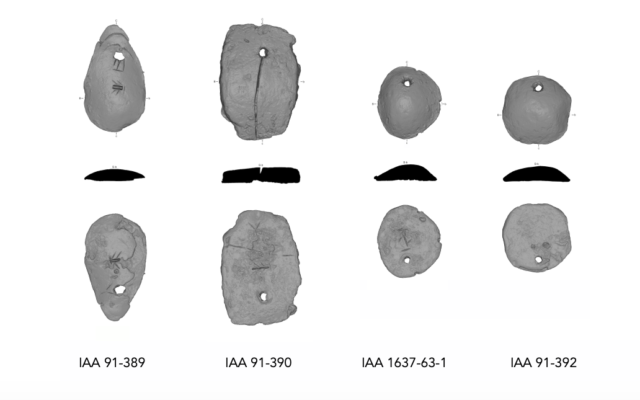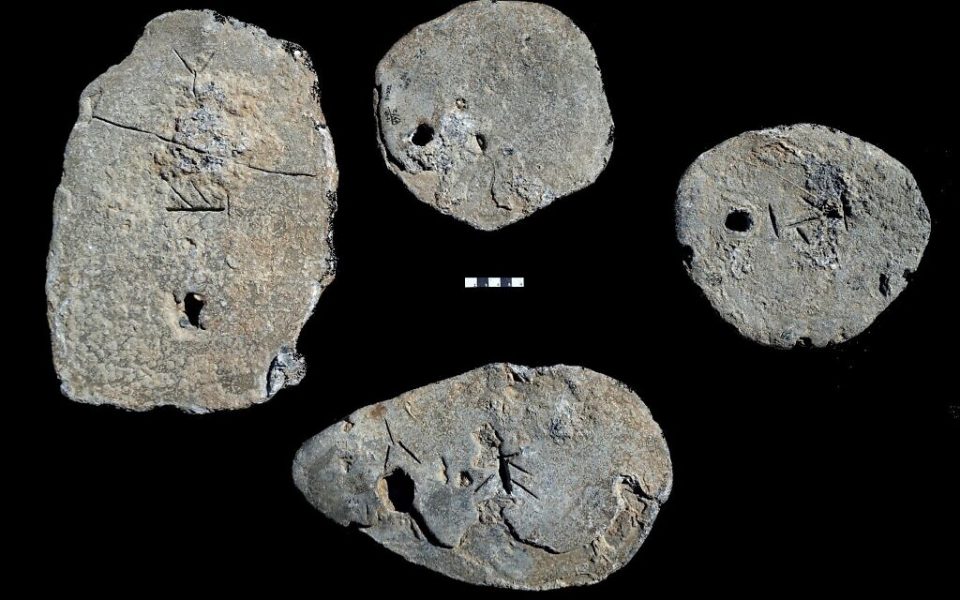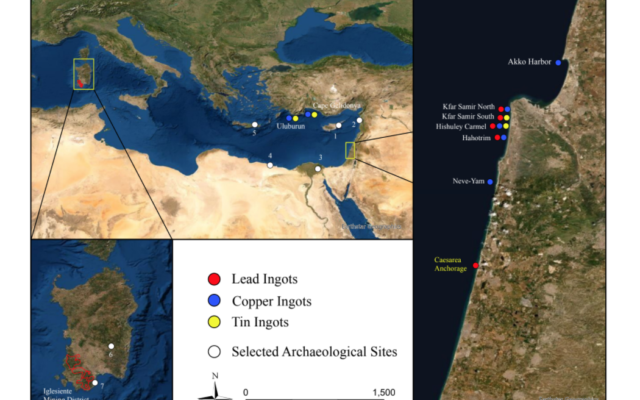New analysis of four 3,200-year-old lead ingots from shipwrecks off the coast of Caesarea redraws late Bronze Age trade routes and may shift researchers’ understanding of Cyprus’s geopolitical role.
The recently published study in the Journal of Archaeological Science: Reports, “Incised Late Bronze Age lead ingots from the southern anchorage of Caesarea,” takes a new look at four lead ingots originally recovered in dives in the late 1980s, which were etched with indecipherable Cypro-Minoan markings used by Cypriots in the 13th–early 12th century BCE.
“It was a bit of a detective story,” said co-author Prof. Naama Yahalom-Mack of the Hebrew University’s Institute of Archaelogy in conversation Monday. “We started from the markings and went on to the metal itself to understand where it comes from. First of all what it is, then to see in isotopic analysis that the lead’s ‘fingerprint’ points us to Sardinia.” She noted that Sardinia is an unexpected place of origin for these presumably Cypriot ingots because it is “beyond the western Mediterranean, beyond the [Cypriots’] regular route of trade, which is Egypt, the Levant, Anatolia and the Aegean.”
According to Yahalom-Mack, Cyprus was once thought of as a “passive” bit player, merely a producer of copper for others to buy and sell in the international metals trade. Bronze, the ubiquitous metal of the era, is forged through a combination of tin, lead and copper.
However, new interdisciplinary research published jointly by the Hebrew University of Jerusalem and the University of Haifa describes a small but agile nation with both formal and informal trade ties that may well have helped fill the power vacuum that occurred with the collapse of entrenched empires around 1200 BCE.
“The Late Bronze Age in the Mediterranean region is one of the more interesting periods in terms of trade and connectivity between cultures and palatial centers,” she said, speaking from her current excavation.
Ancient texts and artifacts show broad trade webs with “extensive diplomatic connections, exchanging gifts, trading raw materials, particularly metals,” she said.
What the new study points to is that “along with formal trade expressed in texts, there is informal trade — smaller ships, entrepreneurs, taking advantage of formal trade and hitching a ride on it,” she said.
The four recently re-analyzed lead ingots were recovered during coastal surveys in 1987 and 1989 conducted by Dr. Ehud Galili from the University of Haifa’s Institute for Maritime Studies. According to the study, there are 22 Bronze Age shipwrecks off the coast of Israel and a proliferation of oxhide (20-plus kilogram) copper ingots and other metals have been recovered. Copper, lead, and tin were sold to port cities along the coastlines, including the shores of today’s Israel, according to a Hebrew University press release.
“Basically everything got swept away and only the heavy stuff remained” from the shipwrecks, said Yahalom-Mack. “So we’re left with part of the cargo and learn from the remains something about the entire story — what happened, when did it happen, what was he [the trader] looking for along this coast.”

3D scans of the Late Bronze Age lead ingots from Caesarea. (Avshalom Karasik/Israel Antiquities Authority)
The interdisciplinary team completed the study using methods taken from the natural sciences in collaboration with Prof. Yigal Erel at Hebrew University’s Institute of Earth Sciences and Prof. Assaf Yasur-Landau of the University of Haifa’s Institute for Maritime Studies, including geology, typology, the analysis of the script and other lead remains from Egypt, and “suddenly a picture comes together,” said Yahalom-Mack. And it’s not the picture that was originally drawn vis-à-vis Cyprus.
The discovery of ingots — etched at the mine in Sardinia with Cypro-Minoan markings — shows that Cyprus was not only producing copper, but was exchanging and trading it for other metals, she said. (Cyprus and Sardinia are located more than 2,500 kilometers, 1,550 miles, from one another.)
“Cyprus was considered to be passive, producing the copper and maybe Levantine traders or this entity or another was taking or buying the copper, trading along the Mediterranean,” said Yahalom-Mack.
This new understanding of an active Cypriot trade route gives rise to many more questions about the island nation to be explored in further research, she said. “These people that have this amazing copper production system on the island… They’re producing tons and tons of copper that reaches all around the Mediterranean and beyond, but how? Who is doing the trading?”
Yahalom-Mack said there is some evidence that Canaanites may have been involved. She said the current study is “another brick in the building” that is taking Cyprus from a passive player to a more active player, but much more work is needed.
“Who exactly is behind this trade? We know it’s going on but to really understand the mechanism? We’re still working on it,” she said.




